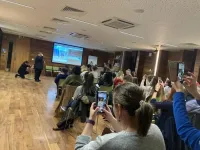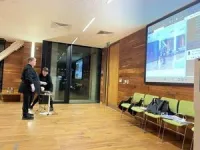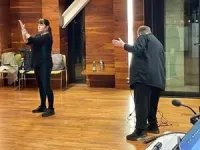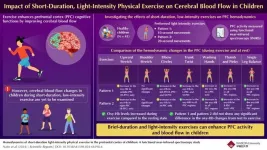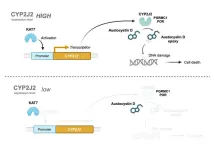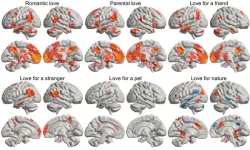(Press-News.org) A new study uses co-creation with reference communities to develop an app for sign language machine translation (SLMT). The research team designed a theatrical performance in sign language, seen through the eyes of artificial intelligence (AI), as one of the methodologies. “Historically, deaf people have been excluded from the development of automatic translation technologies,” says Shaun O’Boyle, Research Fellow in the School of Inclusive and Special Education (Dublin City University DCU). “This has often caused backlash and resistance from deaf communities, as the projects were designed and developed without any input from the very end-users they intended to serve—resulting in a technology no one wanted to use and a big waste of money,” adds Davy Van Landuyt, Project Manager at the European Union of the Deaf (EUD). The team decided to reverse the standard approach. The results of their work are described in a new paper published in the Journal of Science Communication JCOM.
O’Boyle, Van Landuyt, and the other partners of the European project SignON—including the Vlaams GebarentaalCentrum (Flemish Sign Language Centre)—designed an innovative co-creation methodology based on this idea: If we were to introduce an AI to Shakespeare texts in Irish Sign Language, which extracts would we choose first? This engagement with the AI allowed them to connect with the audience and gather their opinions about the technology. “We looked hard at what deaf communities really wanted (and equally important didn’t want),” explains Van Landuyt.
“It was a group effort, and it was a lot of fun,” comments O’Boyle, an expert in science communication and community engagement, who co-authored the paper with Van Landuyt, Elizabeth Mathews (who works with O’Boyle at DCU) and others. The co-creation activity of the project, which contributed to the development of an SLMT app prototype, mixed live theatrical performance with artificial intelligence tools in a setting that reversed the stereotypical perspective between deaf/hard of hearing people and hearing people. “We combined performance with an audience discussion, so to have that element of a focus group technique but within the context of culture and art and seeing a show, and being out for the night,” explains O’Boyle.
The event, titled All the World’s a Screen, was held during Dublin’s Science Week and consisted of a theatrical performance based on the works of William Shakespeare, performed in Irish Sign Language by two deaf actors, Lianne Quigley and Alvean Jones, who are also co-authors of the research and who translated Shakespeare's texts into Irish Sign Language. The audience was composed of deaf, hard of hearing, and hearing people. “For deaf people, it was really important to have a performance and science engagement in their own language rather than in English. In our performance, an interpreter provided access to hearing people,” explains O’Boyle. “It shifted the dynamic, but it also gave people an opportunity to imagine the future of these technologies because we asked people to view the performance with their AI ‘co-spectator’.”
During the performance, in fact, spectators could access tools for real-time analysis of the performers' movements, object recognition, and real-time transcription of the spoken English translation by the interpreters. “We got so much interesting feedback and the great thing about doing it within the context of a research project was that all of that feedback went straight to our team. It informed the use cases for the app, it informed how we spoke about it, how we thought about it, and different aspects of the technology that was developed too,” says O’Boyle.
“The ethical side is also important,” adds Van Landuyt.
“A major frustration of deaf communities are attitudes or motivations of some hearing researchers working on these technologies. Too often ‘hearing’ decision-makers or researchers think that they know better than deaf communities and try to create something which is then rejected by the actual end-users of those technologies, simply because it is not what they want or even utterly useless in practice. I think about, for example, technologies such as signing gloves,” says Van Landuyt, who also explains that this leads to a waste of time and resources. “Just including deaf people in a project is not a structural solution. It does not mean that they are leading the research. Deaf researchers are often only asked to collaborate after the initial idea has already been conceived, the team built, the research conducted, or even near the end of the project,” he adds.
By engaging in authentic co-creation and science communication with deaf communities, this can be mitigated. “We cannot stop the evolution of these technologies, so we need to figure out how to deal with them. It’s essential that deaf people can decide for themselves,” concludes Van Landuyt. “Nothing about us without us.”
The paper A deaf-centered art-science approach to community engagement with sign language technologies can be read for free in JCOM.
Link to Video: That is the question
END
Shakespeare in sign language, seen through AI
Theater, artificial intelligence, and co-creation with deaf communities come together to design an automatic translation app. New paper in JCOM
2024-08-26
ELSE PRESS RELEASES FROM THIS DATE:
PLOS and the University of South Carolina announce APC-free Open Access publishing agreement
2024-08-26
SAN FRANCISCO — The University of South Carolina and the Public Library of Science (PLOS) today announced a three-year Open Access agreement that allows researchers to publish in PLOS journals[1] without incurring article processing charges (APC). This partnership brings together two organizations that believe researchers should be able to access content freely and make their work available publicly, regardless of their access to funds.
“The evidence is undeniable — open research enables the convergence of ...
Why children can’t pay attention to the task at hand
2024-08-26
COLUMBUS, Ohio – Scientists have learned that children find it hard to focus on a task, and often take in information that won’t help them complete their assignment. But the question is, why?
In a new study, researchers found that this “distributed attention” wasn’t because children’s brains weren’t mature enough to understand the task or pay attention, and it wasn’t because they were easily distracted and lacked the control to focus.
It now appears that kids distribute their attention broadly either out of simple curiosity or because their working memory isn’t developed enough to complete a task without “over ...
Short-duration, light-intensity exercises improve cerebral blood flow in children
2024-08-26
Cognitive functions, also known as intellectual functions, encompass thinking, understanding, memory, language, computation, and judgment, and are performed in the cerebrum. The prefrontal cortex (PFC), located in the frontal lobe of the cerebral cortex, handles these functions. Studies have shown that exercise improves cognitive function through mechanisms such as enhanced cerebral blood flow, structural changes in the brain, and promotion of neurogenesis. However, 81% of children globally do not engage in enough physical activity, leading to high levels of sedentary behavior and insufficient exercise. This lack of physical ...
Exploring the role of cytochrome oxygenases in augmenting austocystin D-mediated cytotoxicity
2024-08-26
Austocystin D, a natural compound produced by fungi, has been recognized for its cytotoxic effects and anticancer activity in various cell types. It exhibits potent activity even in cells that express proteins associated with multidrug resistance, attracting significant global research interest. Austocystin D promotes cell death by damaging their DNA, a process which might be dependent on cytochrome P450 (CYP) oxygenase enzymes. Notably, austocystin D has shown significant activity against cancer cells with increased CYP expression. However, the specific role and function of the CYP2J2 enzyme in the cytotoxicity of austocystin D remain ...
Knowing you have a brain aneurysm may raise anxiety risk, other mental health conditions
2024-08-26
Research Highlights:
People diagnosed with unruptured cerebral aneurysms (weakened areas in brain blood vessels) who are being monitored without treatment have a higher risk of developing mental illness compared to those who have not been diagnosed with a cerebral aneurysm. The largest impact was among adults younger than age 40.
The study conducted in South Korea found that the psychological burden caused by the diagnosis of an unruptured aneurysm may contribute to the development of mental health conditions, such as anxiety, stress, depression, eating ...
Non-cognitive skills: the hidden key to academic success
2024-08-26
A new Nature Human Behaviour study, jointly led by Dr Margherita Malanchini at Queen Mary University of London and Dr Andrea Allegrini at University College London, has revealed that non-cognitive skills, such as motivation and self-regulation, are as important as intelligence in determining academic success. These skills become increasingly influential throughout a child's education, with genetic factors playing a significant role. The research, conducted in collaboration with an international team of experts, suggests that fostering non-cognitive skills alongside cognitive abilities could significantly improve educational ...
Finding love: Study reveals where love lives in the brain
2024-08-26
We use the word ‘love’ in a bewildering range of contexts — from sexual adoration to parental love or the love of nature. Now, more comprehensive imaging of the brain may shed light on why we use the same word for such a diverse collection of human experiences.
‘You see your newborn child for the first time. The baby is soft, healthy and hearty — your life’s greatest wonder. You feel love for the little one.’
The above statement was one of many simple scenarios presented to fifty-five parents, self-described as being in a loving relationship. Researchers from Aalto University utilised ...
Researchers develop high-entropy non-covalent cyclic peptide glass
2024-08-26
Researchers from the Institute of Process Engineering (IPE) of the Chinese Academy of Sciences have developed a sustainable, biodegradable, biorecyclable material: high-entropy non-covalent cyclic peptide (HECP) glass. This innovative glass features enhanced crystallization-resistance, improved mechanical properties, and increased enzyme tolerance, laying the foundation for its application in pharmaceutical formulations and smart functional materials. This study was published in Nature Nanotechnology on ...
Mapping the sex life of Malaria parasites at single cell resolution, reveals the genetics underlying Malaria transmission
2024-08-26
Malaria is caused by a eukaryotic microbe of the Plasmodium genus, and is responsible for more deaths than all other parasitic diseases combined. In order to transmit from the human host to the mosquito vector, the parasite has to differentiate to its sexual stage, referred to as the gametocyte stage. Unlike primary sex determination in mammals, which occurs at the chromosome level, it is not known what causes this unicellular parasite to form males and females. New research at Stockholm University has implemented high-resolution genomic tools to map the global repertoire of genes ...
Communicating consensus strengthens beliefs about climate change
2024-08-26
Climate scientists have long agreed that humans are largely responsible for climate change. However, people often do not realize how many scientists share this view. A new 27-country study published in the journal Nature Human Behaviour finds that communicating the consensus among scientists can clear up misperceptions and strengthen beliefs about climate change.
The study is co-led by Bojana Većkalov at the University of Amsterdam and Sandra Geiger of the University of Vienna. Kai Ruggeri, professor of health policy and management at Columbia University Mailman School of Public Health, is the corresponding author.
Scientific consensus identifying humans as primarily ...
LAST 30 PRESS RELEASES:
Injectable breast ‘implant’ offers alternative to traditional surgeries
Neuroscientists devise formulas to measure multilingualism
New prostate cancer trial seeks to reduce toxicity without sacrificing efficacy
Geometry shapes life
A CRISPR screen reveals many previously unrecognized genes required for brain development and a new neurodevelopmental disorder
Hot flush treatment has anti-breast cancer activity, study finds
Securing AI systems against growing cybersecurity threats
Longest observation of an active solar region
Why nail-biting, procrastination and other self-sabotaging behaviors are rooted in survival instincts
Regional variations in mechanical properties of porcine leptomeninges
Artificial empathy in therapy and healthcare: advancements in interpersonal interaction technologies
Why some brains switch gears more efficiently than others
UVA’s Jundong Li wins ICDM’S 2025 Tao Li Award for data mining, machine learning
UVA’s low-power, high-performance computer power player Mircea Stan earns National Academy of Inventors fellowship
Not playing by the rules: USU researcher explores filamentous algae dynamics in rivers
Do our body clocks influence our risk of dementia?
Anthropologists offer new evidence of bipedalism in long-debated fossil discovery
Safer receipt paper from wood
Dosage-sensitive genes suggest no whole-genome duplications in ancestral angiosperm
First ancient human herpesvirus genomes document their deep history with humans
Why Some Bacteria Survive Antibiotics and How to Stop Them - New study reveals that bacteria can survive antibiotic treatment through two fundamentally different “shutdown modes”
UCLA study links scar healing to dangerous placenta condition
CHANGE-seq-BE finds off-target changes in the genome from base editors
The Journal of Nuclear Medicine Ahead-of-Print Tip Sheet: January 2, 2026
Delayed or absent first dose of measles, mumps, and rubella vaccination
Trends in US preterm birth rates by household income and race and ethnicity
Study identifies potential biomarker linked to progression and brain inflammation in multiple sclerosis
Many mothers in Norway do not show up for postnatal check-ups
Researchers want to find out why quick clay is so unstable
Superradiant spins show teamwork at the quantum scale
[Press-News.org] Shakespeare in sign language, seen through AITheater, artificial intelligence, and co-creation with deaf communities come together to design an automatic translation app. New paper in JCOM
